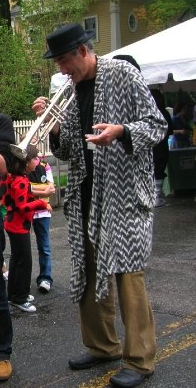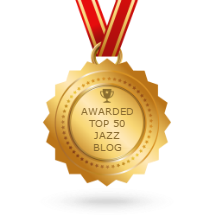Author Alan Kurtz's thesis is: since at least the turn of the 20th century, African-American performers have been fulfilling and/or re-inforcing stereotypes of the naturally-rhythmic primitive savage-i.e., sustaining "white ethnocentric fantasies"-to advance their careers. Episodes include: Minstrelsy, the "coon song" craze, vaudeville, popular black theater ("In Dahomey," Shuffle Along," etc), Ellington's "Jungle Music," Louis Armstrong, Fats Waller and Cab Calloway, bebop, R&B, the jazz avant-garde of the 60's, disco and rap/hip hop.
Mr. Kurtz says he wants the book to "rankle" and just to make sure-unlike Monty Python's Inquisitioners-he never bothers with the comfy chair. Instead, he wields the weapons of sarcasm and innuendo. The rhetorical bombast doesn't fully negate the credibility of his thesis, but it does make reasoned argument and subtle analysis seem less important to the author than the need to vent.
 Mr. Kurtz would like to re-write the book on many musicians, including Dizzy Gillespie and John Coltrane. He calls Dizzy the "Carmen Miranda of Bebop," whose interest in Latin rhythms was calculated solely to take advantage of pop trends and broaden his popularity. It's interesting that Dizzy kept up that charade for another 50 years.
Mr. Kurtz would like to re-write the book on many musicians, including Dizzy Gillespie and John Coltrane. He calls Dizzy the "Carmen Miranda of Bebop," whose interest in Latin rhythms was calculated solely to take advantage of pop trends and broaden his popularity. It's interesting that Dizzy kept up that charade for another 50 years. Mr. Kurtz sucks all the spirituality out of Coltrane's life and music and simply reduces him to being one of the purveyors of "New Black Music" of the 60's. "...the New Black Music," he says, "represented no one and nothing beyond the lacerated ulcerations of a few pathologically dyspeptic outpatients with saxophones."
Almost half the book is given over to an analysis of hip hop lyrics. It is a wearisome litany for several reasons. First, for little-old bourgeois me the lyrics themselves are pretty vile. They speak for themselves, but Mr. Kurtz won't let them. A biting and incessant sarcasm accompanies us through the journey. Was hip hop's lifestyle and music simply a play for more market share, a reversion to savagery or might there be some other social elements at play? The author does attempt to provide a cultural context, but the parameters of his context consist only of censorship-crazed prigs, calculating records execs and gagstas. Any other approach to hip hop gets not short shrift-it gets no shrift.
Mr. Kurtz chooses to look at episodes like Louis Armstrong wearing a jungle costume in a Hollywood movie not in the light of the pervasive racism of the time, nor does he leave room for the possibility of Armstrong's transcending the trappings of the part. In this book, character is one-dimensional, motivations base and deeds irreversible. This is why Abbey Lincoln's posing for an early processed-hair ad means her future political activity can't be taken seriously.
 Does he occasionally sweep away some race-based cant? Yes. For example, his analysis of the difference between Joe Turner and Bill Haley's version of "Shake, Rattle and Roll" seems on the money: it was energy that elevated Haley over Turner, not racism. His explanation of why and how some black R&B artists were able to cross over without compromise is well reasoned.
Does he occasionally sweep away some race-based cant? Yes. For example, his analysis of the difference between Joe Turner and Bill Haley's version of "Shake, Rattle and Roll" seems on the money: it was energy that elevated Haley over Turner, not racism. His explanation of why and how some black R&B artists were able to cross over without compromise is well reasoned.
Mr. Kurtz's breezy style often seems out of place, but is easy to read and sometimes good for a laugh, as when he calls a Life magazine round table on modern art "..an overlong exhalation of hot air by Fifteen Distinguished Windbags."
There's an occasional hint that the author sees more layers than he lets on, saying that the goal of "Enacting totems of their own debasement," may perhaps be "...to defuse the totem's power by, in effect, beating your enemy to the punch–-even if it means punching yourself in the face." Then, he adds: "Or it may betray a deeper sense of collective inferiority."
He puts a disclaimer in the first chapter: "This is not an indictment of African Americans as a whole or of their music generally[his bold], but rather a critical look at one microscopic slice of black culture." That seems to be an invitation to judge his ideas on their own merit, but the author's narrow perspective undermines that effort.
Once in a while, it would have been nice for Mr. Kurtz to step back, take a deep breath and enjoy the music of an ocean vista. As it is, he chooses to relentlessly scrutinize a single drop of water trapped on a microscope slide, and everything he sees looks like it escaped from a horror movie.
Once in a while, it would have been nice for Mr. Kurtz to step back, take a deep breath and enjoy the music of an ocean vista. As it is, he chooses to relentlessly scrutinize a single drop of water trapped on a microscope slide, and everything he sees looks like it escaped from a horror movie.
For another perspective on this book, there's an excellent analysis done by Ed Leimbacher at his blog Eye Witness.
I also suggest reading the various, contentious blog postings about Randy Sandke's book "Where the Dark and the Light Folks Meet: Race and the Mythology, Politics, and Business of Jazz."
I also suggest reading the various, contentious blog postings about Randy Sandke's book "Where the Dark and the Light Folks Meet: Race and the Mythology, Politics, and Business of Jazz."




